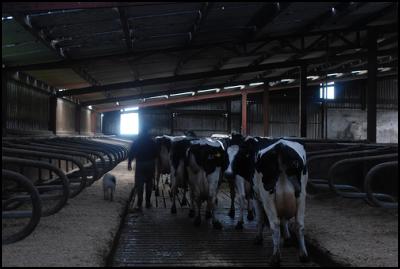Anne Else: A fair adjectival cow
A fair adjectival cow: Why cubicle farming is a really bad idea

Click for big
version
Cubicle farming of cows in Northern Ireland
(Image: sarahluv, CC, Flickr.)
A handy guide to Newzild, issued to US servicemen during the war, says that "a fair cow" or, more forcefully, "a fair adjectival cow", means “an unpleasant man, woman or situation”. It's exactly the right term, I reckon, to describe the plan to house 18,000 cows in cow cubicles in the Mackenzie Basin.
The cows would stay inside all day and night for 8 months of the year, lying down in what are called "cow cubicles". Even in summer they would spend 12 hours a day inside. They would spend only 121 days grazing - well under the EU minimum of 150 days for "organic production friendly" milk.
The cubicle system designer is called TechniPharm. Its chief executive officer, Harmen Heesen, says the barns are "a far more sophisticated way to run a farm".
Tim Deane, Fonterra milk supply manager, says the company has "real concerns" about the environmental sustainability of stall-based farming. New Zealand had been showcased as an example of a country using free-range systems by the World SPCA. "We don't believe stall-based farming of this type is consistent with New Zealand's reputation as a source of dairy products from substantially grass-fed cows."
 The
Prime Minister is rather less concerned. He thinks that it
will all be okay because "the reality is the bulk of New
Zealand farming is done on a pastoral basis," and "Anyone
who drives around New Zealand will see that."
The
Prime Minister is rather less concerned. He thinks that it
will all be okay because "the reality is the bulk of New
Zealand farming is done on a pastoral basis," and "Anyone
who drives around New Zealand will see that."
Only problem is, the people who buy our dairy products don't usually get to "drive around New Zealand". If they're told about the influx of cubicle farming - as they surely will be - then the "clean green" image we depend on so heavily will be completely down the tubes.
I'm not a vegetarian, let alone a vegan, and I don't stick to organically produced food. But I do care about how the animals that produce my food are treated. And I'm convinced that ensuring our already rather battered claims to be clean, green and 100% pure become a reality is the only way our economy can survive, let alone prosper.
I was flabbergasted to hear Federated Farmers quoted as saying that by using cow cubicles, New Zealand was simply catching up with the rest of the world. Don't they get it? The only advantage New Zealand has in dairying terms is that it is DIFFERENT from the rest of the world.
In fact FF does know this, and explicitly recognised it just a few months ago, as the Green Party has pointed out:
"In May, Federated Farmers lauded the value of animal freedom and natural grass feed that consumers can ‘taste’, to promote New Zealand butter in the UK: ‘Grazing outdoors on GM free grass and natural winter feed makes for happy cows and fantastic quality milk … British consumers literally taste freedom when they eat New Zealand butter.’"
Not if these farms go ahead. And I doubt that Fonterra will be keeping the cubicle cow milk separate from the rest. So the reputation of our entire dairy production will be tainted.
We do not, of course, have any legal way of stopping such operations, other than denying them resource consent, or ruling that their arrangements do not meet animal welfare standards. But after the appalling conditions that some pork farmers seem to be able to get away with, while still being deemed to meet these standards, the prospects of the cow cubicle plan not being approved are to looking too flash. Because this is a standard practice in the EU, there are plenty of regulations about cubicle farming which the applicants will be able to say they are meeting.
So what, exactly, is wrong with cubicle farming?
No one has asked about what the 18,000 cubicle cows will be fed. But it's highly likely that it will involve palm kernel expeller. If you Google "palm kernel" for NZ, you'll find lots of sites extolling its virtues as "simple, safe" feed, with high energy value - due to the residue of oil left in it.
I recently read The Omnivore's Dilemma (Michael Pollan), which goes into graphic detail about the industrialisation of food production and what happens when you feed corn to cows designed to eat grass. I felt quite smug about the fact that OUR dairy cows and beef cattle are fed mainly on grass.
But apparently I was wrong, because soon after, the story about New Zealand's massive imports of palm kernel expeller- a second saleable product created by the immensely destructive palm oil industry - broke in the Sunday Star Times.
To feed the cows we have now, we already import 1,104,387 tonnes of palm kernel expeller, close to a quarter of the world supply - a rate of consumption second only to the combined 27 countries of the European Union. We could feed the cows on locally grown grain, but this is cheaper. Financially, that is.
Lachlan McKenzie, dairy farmers chairman, has said that "most people don't believe the recycling of a waste by-product like palm kernel expeller into animal feed is a bad thing, so long as it comes from certified sources. Especially if that waste would otherwise be burnt or just left to rot".
This is an utterly specious argument. Only 330,000 tonnes of world production is currently certified. The rest is produced by destroying fragile rainforest environments. By feeding palm kernel to cows we become complicit in that destruction - especially when sustainable and affordable alternatives are locally available.
There have also been claims that there are major biosecurity risks in importing this form of feed. Federated Farmers biosecurity spokesman, John Hartnell, says that for a long period of time, it has been "questioning the biosecurity risks posed by what seems to be a great amount of uncertified palm kernel entering New Zealand. There's a huge biosecurity hole posed by the stuff."
What about those cow cubicles? The web has some handy sites advertising cow cubicles, with little videos of how they work. It's not a pretty sight. It also poses specific risks to cow health, (though of course the cubicle ads don't go into this). A British vet's paper explains exactly why.
"Laminitis and sole ulcers were rare before the advent of SLATS or CUBICLES. Today, laminitis is the main cause of lameness in cattle. Risk increases when cattle stand with their hind legs in the passage-way, or stand for long times on wet or pitted concrete. Calved heifers are especially at risk. The outer claw of the hind limb is most frequently affected in lameness..."
The correct balance and type of feed is a problem too: get it wrong, and cows can develop "fatty liver syndrome, metritis, mastitis and intoxications", which are often followed by lameness. In short, a great deal of skilled, specific care and attention is necessary to prevent lameness in cows kept in cubicles - particularly in herds of over 200:
"Lameness incidence increases as herd size increases from >50, to 100-199, to >199 cows. Individual observation and care of cows is more difficult in large than in small herds."
Just last June, the European Food Safety Authority's Panel on Animal Health and Animal Welfare produced a "Scientific Opinion on the overall effects of farming systems on dairy cow welfare and disease". It pointed out that in Europe:
"Systems range from grazing all of the year to remaining in a building with zero-grazing. The farming system by itself is a major factor determining the health problems of dairy cattle and other aspects of their welfare, partly through housing and equipment and partly through management and handling practices."
It's clear from this paper, too, that cubicles cause a wide range of serious health problems if they are not very carefully designed and managed.
Then there's the poo and wee problem. Cows produce vast amounts of effluent, and "dirty dairying" is already a major issue in New Zealand. The amount that will be produced by 18,000 cows is staggering. The applicants say they will be able to handle it all, thanks to the design of their cubicle system.
But it's extremely difficult to see how they will do this, given the arid Mackenzie Basin environment. They have applied for consents to discharge 1.7 million litres of liquid effluent a day from their 16 farms, via proposed irrigation systems. They are also applying to construct three ponds capable of storing 76,000 cubic metres of cow faeces before it is spray irrigated, and to discharge contaminants to the air from the enclosed animals.
Even if they do manage to meet all the requirements and keep damage to cows' health, and to the environment, to a minimum, what is the point of farming this way in grassy, temperate New Zealand? There can be only one answer: because it enables inhospitable, fragile, and otherwise "unprofitable" landscapes, such as the stunning Mackenzie Basin, to be turned into a conglomeration of giant factory farms. We will indeed be catching up with the rest of the world.
ALSO: Scoop Audio - Key Discusses Factory Farming at the Post-Cabinet Prime Minister's Press Conference
Anne Else is a Wellington writer and social commentator. Her occasional column will typically appear on a Monday. You can subscribe to receive Letter From Elsewhere by email when it appears via the Free My Scoop News-By-Email Service. Anne blogs at http://elsewoman.blogspot.com


 Eugene Doyle: Writing In The Time Of Genocide
Eugene Doyle: Writing In The Time Of Genocide Gordon Campbell: On Wealth Taxes And Capital Flight
Gordon Campbell: On Wealth Taxes And Capital Flight Ian Powell: Why New Zealand Should Recognise Palestine
Ian Powell: Why New Zealand Should Recognise Palestine Binoy Kampmark: Squabbling Siblings - India, Pakistan And Operation Sindoor
Binoy Kampmark: Squabbling Siblings - India, Pakistan And Operation Sindoor Gordon Campbell: On Budget 2025
Gordon Campbell: On Budget 2025 Keith Rankin: Using Cuba 1962 To Explain Trump's Brinkmanship
Keith Rankin: Using Cuba 1962 To Explain Trump's Brinkmanship